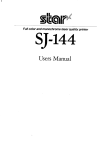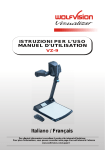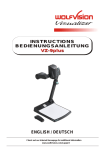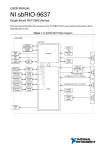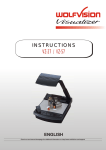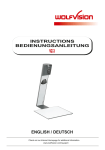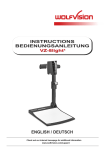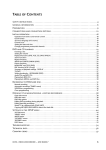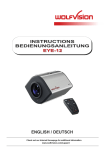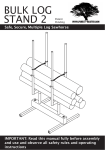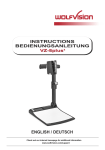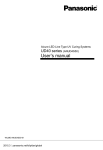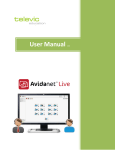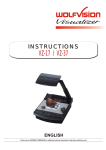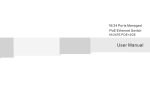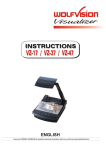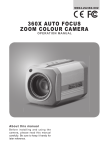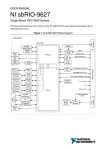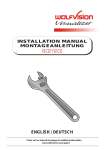Download User Manual SCB-12
Transcript
USERMANUAL SCB-12 Version 1.5 Table of Contents Table of Contents I Copyright Information............................................................................................................... 4 II About this user manual ............................................................................................................ 4 III Symbols in this manual ............................................................................................................ 5 1 1.1 1.2 Precaution.................................................................................................................................. 6 Labels on the remote control (optional) ....................................................................................... 7 Approval marks on the unit.......................................................................................................... 7 2 2.1 2.2 Contents of packaging.............................................................................................................. 8 SCB-12 standard set ................................................................................................................... 8 SCB-12 Test set .......................................................................................................................... 8 3 3.1 Features ..................................................................................................................................... 9 Picture Size ................................................................................................................................. 9 4 4.1 4.2 4.3 4.4 4.5 Pin assignment........................................................................................................................ 12 Left side..................................................................................................................................... 12 Rear .......................................................................................................................................... 13 Bottom ....................................................................................................................................... 14 Interface Board (optional) .......................................................................................................... 15 Infrared Remote Control ............................................................................................................ 16 5 5.1 5.2 5.3 5.4 5.5 5.6 5.7 5.8 FUNCTIONS ............................................................................................................................. 18 Zoom ......................................................................................................................................... 18 Auto Iris / Manual Iris................................................................................................................. 18 Focus / Autofocus ..................................................................................................................... 18 Preset Function ......................................................................................................................... 19 White Balance ........................................................................................................................... 20 Image Memory for 9 images...................................................................................................... 21 Freeze ....................................................................................................................................... 21 Image Turn Mode ...................................................................................................................... 22 6 Working with the SCB-12........................................................................................................ 23 7 7.1 7.2 7.3 7.4 7.5 7.6 7.7 7.8 Connections ............................................................................................................................ 24 DVI-I .......................................................................................................................................... 24 RGB .......................................................................................................................................... 24 Power Plug ................................................................................................................................ 24 RS-232 ...................................................................................................................................... 24 External Infrared (IR) Sensor .................................................................................................... 25 USB ........................................................................................................................................... 25 Ethernet / LAN Port ................................................................................................................... 26 Trigger ....................................................................................................................................... 28 8 8.1 8.2 OSD (On-Screen Menu) OSD Help ......................................................................................... 29 Reset On-Screen Menu Settings............................................................................................... 29 Structure and functions of OSD................................................................................................. 30 9 Resolution and refresh rate.................................................................................................... 54 10 10.1 10.2 10.3 10.4 10.5 MAINTENANCE ........................................................................................................................ 56 Firmware Upgrades ................................................................................................................... 56 IR (Infrared) Remote Control ..................................................................................................... 56 Different IR-Codes .................................................................................................................... 56 Cleaning .................................................................................................................................... 57 Transportation ........................................................................................................................... 57 11 Technical Specifications ........................................................................................................ 58 12 Dimensions .............................................................................................................................. 60 13 13.1 13.2 13.3 13.4 Installation ............................................................................................................................... 61 Eclipse....................................................................................................................................... 61 Cooling ...................................................................................................................................... 62 Matrix for key panel ................................................................................................................... 63 Recommended Positioning of Light........................................................................................... 64 14 OPTIONAL WolfVision Accessories ...................................................................................... 66 Version 1.5 2 Table of Contents 14.1 14.2 14.3 External WolfVision Lightbox .................................................................................................... 66 Close-Up Lens .......................................................................................................................... 66 Working surface ........................................................................................................................ 66 15 15.1 15.2 15.3 15.4 15.5 Troubleshooting ..................................................................................................................... 67 Check ....................................................................................................................................... 67 Power (depends on customer installation) ................................................................................ 67 IR-remote control (optional) ...................................................................................................... 67 Image........................................................................................................................................ 68 Connections .............................................................................................................................. 69 16 16.1 16.2 16.3 16.4 Warranty .................................................................................................................................. 70 General ..................................................................................................................................... 70 Dead on arrival (DOA) .............................................................................................................. 70 Not covered by warranty ........................................................................................................... 70 Transit damage or loss: ............................................................................................................ 71 17 17.1 17.2 Disposal of old WolfVision units ........................................................................................... 72 In the European Union .............................................................................................................. 72 Outside of the European Union ................................................................................................ 72 3 Version 1.5 Copyright I Information Copyright Information Copyright © by WolfVision. All rights reserved. WolfVision, Wofu Vision and 沃 福 视 讯 are registered trademarks of WolfVision Holding AG, Austria. No part of this document may be copied, reproduced, or transmitted by any means, without prior written permission from WolfVision. Except documentation kept by the purchaser for backup purposes. In the interest of continuing product improvement, WolfVision reserves the right to change product specifications without notice. Information in this document may change without notice. Disclaimer: WolfVision shall not be liable for technical or editorial errors or omissions. The units are "MADE IN EU/AUSTRIA” Date of printing Printed in Austria October 2011 II About this user manual This user manual explains the SCB-12 and all of its contents. Please keep this user manual for later reading. When selling the SCB-12 please give this user manual to the next owner. Version 1.5 4 Information III Marks in this manual Symbols in this manual Position numbers are written in bold, italic characters and marked with the symbol "#", i.e. #1 for connections. Safety information is marked with corresponding pictographs and the instruction sequences are marked with the symbol "". The word Danger indicates possible serious personal injury. The word Warning indicates possible personal injury and/or serious equipment damage. The word Attention indicates possible personal injury and/or equipment damage. High voltage. Risk of electric shock. Hot surface. Risk of get burnt. Laser beam. Risk of injury. Risk of possible material damages. Advise for disconnecting the unit from mains. Recycle used components. Additional information. 5 Version 1.5 Precaution 1 Information Precaution RISK OF ELECTRIC SHOCK Use this unit only with the correct voltage as shown on the type label. Do not expose the unit to extreme heat or moisture. Do not expose the unit to water, metallic objects or any flammable material. Make sure that sufficient air circulation for cooling the unit is possible! Do not use a damaged power cord / power supply. This may cause short circuits or electrical shocks! To prevent danger, do not modify the unit or operate it without a case. Never use the unit without case. Never touch the power supply or power cord with wet fingers. If the unit is not used for a long time, disconnect it from mains! The power source equipment has to be approved by CSA or UL in accordance to CSA 22.2-60950 or UL 1950. And it shall comply with all applicable local and national codes related to safety. The Power over Ethernet power equipment (PoE PSE) shall be classified as Limited Power Source (LPS) in accordance with IEC 60950-1:2001. RISK OF HURTING YOUR EYES Do not stare into laser beam of the remote control. Laser class II Wavelength 650 nm The laser is conform to EN 60825-1 March 1997. The laser beam exits the remote control through the smaller (left) opening on the front. RISK OF DAMAGING THE UNIT Protect the unit from excessive shocks. Do not expose the unit to extreme heat or moisture. Do not expose the unit to water, metallic objects or any flammable material. Make sure that sufficient air circulation for cooling the unit is possible! If there is any abnormality (abnormal noise, smell, smoke etc.) disconnect the unit from mains immediately and contact your WolfVision dealer! Avoid installing the unit in environments where there is radiation. Avoid installing the unit in locations exposed to strong magnetic fields or electrical currents. This could cause monitor image distortion or damage to the CCD camera. Never use strong cleaning agents! Version 1.5 6 Information 1.1 Labels and Approvals Labels on the remote control (optional) Laser Information FDA accession number: 9912688-00 This laser device complies with the restriction: 21 CFR 1040.10 und 1040.11 The remote control is included in the SCB-12 Test set. This label will be found on the underneath of the remote control. Technical data of the laser diode: λ = 635 - 680nm P < 1mW Θ ≤ 2mrad 1.2 Approval marks on the unit As the SCB-12 is a camera module for OEM-customers it has no FCC or CE approvals. The customer is responsible for FCC, CE and other necessary approvals. 7 Version 1.5 Content of packaging 2 Contents of packaging 2.1 SCB-12 standard set Following components are included in the carton box*: • SCB-12 • Quick manual all signals will be provided through JST and Molex-connectors. 2.2 SCB-12 Test set Following accessories are included with the SCB-12 Test set: • Interfacing board for SCB-12 • Lockable power connector • BNC-RCA adapter for trigger input • IR-remote control with laser pointer • External IR-receiver with 10m cable and status LED • Power supply • Power cord • User manual • CD-Rom • VGA cable (D-sub 15pin HD) • USB cable • LAN cable • PoE power injector *Please retain the original packaging for later transports of the SCB-12 and accessories. Version 1.5 8 Camera 3 Features Features The SCB-12 is an ultra-compact color-camera-module with SXGA- resolution (1280x960) and 30 frames per second. With the integrated scan converter, the camera is able to output different resolutions and refresh rates for optimum picture reproduction. The SCB-12 has a high quality lens with 12x optical zoom and 4x digital zoom. The camera module has an auto focus and manual focus, auto iris and manual iris and motorized zoom. There are special features like: trigger function, 9 Presets (remain stored when disconnected from power), Positive/Negative, 9 image memories, Freeze function and Image Turn The SCB-12 can be controlled by RS-232, USB or Ethernet/LAN. It is possible to transfer images via USB or Ethernet/LAN. Supply-voltage is 12VDC (+/- 10%). The PoE function can be used with the WolfVision interfacing board only. 3.1 Picture Size 3.1.1 Chart The following chart shows the connection between distance from the SCB-12 to the object and image size in optical zoom range: *vertical image size = horizontal size 4 x3 Regular Distance From 0.5 to 10 Meters [1.64 to 32.81']. 9 Version 1.5 Pin assignment 3.1.2 Camera Picture Size / Distance Camera to Object (examples) Measurements in mm Length x Wide Distance in mm smallest picture with 2x digital zoom smallest picture with optical zoom largest picture 600 22 x 30 44 x 59 392 x 522 800 28 x 37 55 x 73 517 x 589 1.000 33 x 44 66 x 88 642 x 856 1.200 38 x 51 77 x 102 768 x 1.023 1.400 44 x 58 87 x 116 893 x 1.191 1.600 49 x 65 98 x 131 1.143 x 1.525 1.800 54 x 73 109 x 145 1.269 x 1.692 2.000 60 x 80 120 x 159 1.394 x 1.859 2.200 65 x 87 130 x 174 1.394 x 1.859 2.400 71 x 94 141 x 188 1.519 x 2.026 Measurements in inch Length x Wide Version 1.5 Distance in inches [feet] smallest picture with 2x digital zoom smallest picture with optical zoom largest picture 20" [1.67'] 0.77" x 1.03" 1.55" x 2.06" 13.15" x 17.53" 30" [2.50'] 1.04" x 1.39" 2.09" x 2.78" 19.42" x 25.89" 40" [3.33'] 1.31" x 1.75" 2.62" x 3.50" 25.68" x 34.24" 50" [4.17'] 1.58" x 2.11" 3.16" x 4.21" 31.95" x 42.60" 60" [5.00'] 1.85" x 2.47" 3.70" x 4.93" 38.21" x 50.95" 70" [5.83'] 2.12" x 2.82" 4.24" x 5.65" 44.48" x 59.30" 80" [6.67'] 2.39" x 3.18" 4.77" x 6.36" 50.74" x 67.66" 90" [7.50'] 2.66" x 3.54" 5.31" x 7.08" 57.01" x 76.01" 100" [8.33'] 2.92" x 3.90" 5.85" x 7.80" 63.27" x 84.36" 110" [9.17'] 3.19" x 4.26" 6.39" x 8.51" 69.54" x 92.72" 10 Camera 3.1.3 Pin assignment Online Calculation Program (Java) A very easy method to calculate the exact positioning and the possible image sizes of the SCB-12 is the dedicated calculation program on WolfVision's homepage: www.wolfvision.com/wolf/indexdistance.html 11 Version 1.5 Pin assignment 4 Camera Pin assignment For more details regarding the connectors please contact WolfVision Headquarter at [email protected] Keep cable connections as short as possible to prevent interferences. 4.1 Left side #1 Key panel connector (type: ZIF_12_RM1_0) pin1 KYP_AF-LED pin2 KYP_ROW1 pin3 KYP_ROW2 pin4 KYP_ROW3 pin5 KYP_ROW4 pin6 KYP_ROW5 pin7 KYP_COL1 pin8 KYP_COL2 pin9 KYP_COL3 pin10 KYP_COL4 pin11 KYP_COL5 pin12 KYP_COL6 Keep cable connections as short as possible, maximum 10cm. The complete key matrix will be found on page 63 Version 1.5 12 Camera 4.2 Pin assignment Rear #2 Signal connector (type: 60PS-JMDSS-G-1-TF) pin1 GND pin2 IR_Data pin3 LED- pin4 LED+ pin5 RS232_RX pin6 RS-232_TX pin7 GND pin8 DVI_HP_DETECT pin9 DVI_I2C_D pin10 DVI_I2C_C pin11 GND pin12 VGA_I2C_D pin13 VGA_I2C_C pin14 GND pin15 VGA_R pin16 DVI_R pin17 GND pin18 VGA_G pin19 DVI_G pin20 GND pin21 VGA_B pin22 DVI_B pin23 GND pin24 DVI_VSY pin25 VGA_VSY pin26 DVI_HSY pin27 VGA_HSY pin28 GND pin29 TRIGGER_IN pin30 GND pin31 12VDC pin32 12VDC pin33 5VDC pin34 3,3VDC pin35 GND pin36 USB_DMINUS pin37 USB_DPLUS pin38 USB_VBUS pin39 ENET_SPEED pin40 ENET_ACT pin41 GND pin42 ENET_TX- pin43 ENET_TX+ pin44 GND pin45 ENET_2V5 pin46 GND pin47 ENET_RX- pin48 ENET_RX+ pin49 GND pin50 DVI_TX2+ pin51 DVI_TX2- pin52 GND pin53 DVI_TX1+ pin54 DVI_TX1- pin55 GND pin56 DVI_TX0+ pin57 DVI_TX0- pin58 GND pin59 DVI_TXC+ pin60 DVI_TXC- For Ethernet/LAN connection, all "ENET..." lines are necessary, use Tyco socket (Tyco part no. 1-6605834-1). 13 Version 1.5 Pin assignment 4.3 Camera Bottom #3 Infrared receiver connector (type: S5B-ZR) pin1 +5VDC pin2 IRX pin3 GND pin4 LED_C pin5 LED_A Keep cable connections as short as possible. IR-receiver Vishay TSOP 38xx will be preferred. Version 1.5 14 Test set 4.4 Pin assignment - Interfacing board Interface Board (optional) The interface board is included in the SCB-12 Test set or optional available. #4 RS-232 for controlling purposes, see page 24 #5 USB for image transfers to the computer and for controlling, see page 25 #6 Trigger for triggering the unit, see page 28 #7 Ethernet/LAN for image transfers to the computer and for controlling, see page 26 #8 RGB RGB HV signal output, see page 24 #9 IR-EXTERN for connecting an external IR receiver, see page 25 #10 DVI DVI-I signal output, see page 24 #11 POWER power plug, see page 24 15 Version 1.5 IR Remote Control 4.5 Test set Infrared Remote Control #12 ZOOM keys Using the ZOOM keys also switches auto iris on again. #13 PRESET keys (user programmable presets) For storing a preset, press one of the PRESET keys for more than 2 seconds. For recalling a preset, press the PRESET key quickly (see page 19). #14 AUTO FOCUS (AF) key Switches the auto focus on and off. #15 WHITE key Activates one push WHITE BALANCE adjustment (see page 20). #16 FREEZE key Captures the current image (see page 21). #17 ALL key For displaying all 9 pictures of the memory as split image (see page 21). #18 MENU NAVIGATION keys For navigating through the on-screen menu (see page 29ff). #19 MENU key Pressing this key for 1 second activates the on-screen menu (see page 29ff). Version 1.5 16 Test set IR Remote Control #20 LASER indication LED / IR-Code indication LED For indicating the LASER status of the unit (red=on, dark=off). When changing the IR-code on the IR-remote control, the LED flashes in accordance with the selected IR-code (see page 56). #21 LASER POINTER key Important: Do not stare directly into the beam. This is hazardous for your eyes! #22 IMAGE TURN key For picking up vertical (portrait) pages with higher resolution (see page 22). #23 Manual FOCUS keys For focusing the picture. When the Manual FOCUS keys are pressed the SCB-12 switches off the autofocus function. Using the AF key switches the autofocus function on again. #24 Manual IRIS keys (brightness adjustment) When the IRIS keys are pressed, the SCB-12 switches off the auto iris function. The next time the ZOOM keys are used the auto iris is switched on again. For specialists: The auto iris priority can be switched off in the on-screen menu. ("Auto iris priority" means when pressing the ZOOM keys, the auto iris switches on.) The overall brightness level can be set lower or higher in the on-screen menu with "Image Brightness" (see page 29ff). The optimal setting depends on the connected display device. #25 HELP/RESET key for on-screen menu While you are in the on-screen menu you can activate the onscreen help by pressing the HELP key. Pressing this key for 2 seconds resets the selected menu item (see page 29ff). #26 MEMORY keys 1 - 9 For saving and recalling pictures (see page 21). #27 POWER key Switches the unit on and off. When switching the unit on, the SCB-12 automatically runs the power-on preset. 17 Version 1.5 Basic functions 5 Functions FUNCTIONS The SCB-12 can be controlled through a key-matrix, IR-remote control (IR-receiver will be required), via Ethernet/LAN, USB or RS-232. 5.1 Zoom The SCB-12 uses a 12x zoom lens: f=5.8 to 69.6 mm (F=2.8 to 3.0) 5.1.1 Digital Zoom The digital zoom is automatically switched on at the tele end of 12x optical zoom range, with progressive effect from 1 to 4, giving a total maximum of 48x zoom ratio. Digital zoom increases the picture element size and reduces the resolution. The default setting displays a message on-screen when you are in the digital zoom mode. Still pictures in the memory can also be digitally zoomed. You can change the behavior of the SCB-12 in the digital zoom mode in the on-screen menu (see page 29ff). 5.2 Auto Iris / Manual Iris The SCB-12 is equipped with an auto iris function. This means that the brightness of the camera image adjusts automatically. When using the IRIS keys (#24) the auto iris function is switched off. In this mode the iris can be adjusted manually. When using the ZOOM keys (#12) the auto iris is switched on again. The auto iris also controls the Auto Gain and Auto Shutter to extend the iris-range. The auto iris priority can be switched off in the on-screen menu. ("Auto iris priority" means when pressing the ZOOM keys, the auto iris switches on.) The overall brightness level can be set lower or higher in the onscreen menu with "Image Brightness" (see page 29ff). The optimal setting depends on the connected display device. 5.3 Focus / Autofocus The minimum focus distance (MOD) is below 50mm at optical wide end and below 500mm at optical tele end, and is independent of digital zoom. If shorter distances are necessary, a high quality close up lens is available (see optional accessories). Please note that objects with very low contrast e.g. a blank sheet of paper) are difficult to focus. If the autofocus does not work just move the object slightly. For special applications the autofocus can also be switched off using the on/off switch (#14). The autofocus is also switched off when the manual FOCUS keys (#23) are used. Version 1.5 18 Functions 5.4 Basic functions Preset Function The SCB-12 offers the possibility to store the current settings as a preset and recall them by just pressing the respective PRESET key (#16) on the remote control. Pressing the FREEZE key (#16) for 2 seconds recalls preset 1. For storing a preset: adjust any function as required and then press any one of the PRESET keys on the remote control for 2 seconds or more. An on-screen message will inform you when the preset is stored. When presets are stored as mentioned above, all current settings such as zoom, focus, iris etc. are stored. The user can also assign specific functions, such as "Negative", "Negative/Blue", "Black/White" etc. to a PRESET key in the on-screen menu of the SCB-12 (see page 29ff). 19 Version 1.5 Basic functions 5.5 Functions White Balance The correct white balance adjustment is important for exact color reproduction. "Auto Tracking" is the default white balance setting when the SCB-12 is shipped. This means that the white balance is continuously adjusted automatically. For an exact white balance, 10% of the recorded image should be white (measurement area is in the center of the image). For a precisely fixed white balance adjustment use the "One Push" white balance. This can be done by completely zooming in on a white surface and pressing the WHITE key (#15). When the white balance is stored, an on-screen message appears. Setting a "One Push" white balance switches off the "Auto Tracking" mode (when the unit is switched off and on again the "Auto Tracking" mode will be reactivated). When the lighting conditions change (e.g. light box, sunlight or different room light) the white balance should be readjusted! For specialists: The SCB-12 can be switched between "Auto Tracking", "One Push" and "Manual" white balance mode in the onscreen menu (see page 29ff). If you work with negative transparencies and a light box, use a blank (black in the image) piece of the negative film for white balance adjustment! 5.5.1 White balance adjustment errors If the white balance adjustment is not successful, an error message appears on the screen. If this happens, take the necessary measures. White: Too Bright! The video signal level is too high. Take one or more of the following measures and then perform the OWB again: • Remove any brightly illuminated objects • Decrease the illumination • Close the iris opening • Decrease the video gain White: Too Dark! The video signal level is too low. Take one or more of the following measures and then perform the OWB again: • Increase the illumination • Widen the iris opening • Increase the video gain White: Out of Range! Version 1.5 Place a white sheet of paper and perform the OWB again. 20 Functions 5.6 Special functions Image Memory for 9 images The SCB-12 has an image memory from which a stored image can be output as a still image. You can store up to 9 images in the memory. Code Storing an image: Press one of the MEMORY keys (#26) for 2 seconds or more Recalling an image: Press one of the MEMORY keys (#26) quickly View Mode / Splitscreen By pressing the ALL key (#17) a split image with all 9 pictures of the memory can be displayed. Example of a splitscreen The memory can be erased or filled automatically in the on-screen menu of the view mode ALL key (#17). When choosing “Auto Fill”, the SCB-12 stores every second a new image until all 9 memory locations are full. With “Erase All”, all 9 memory locations will be erased and shown with grey content. The SCB-12 is equipped with a static memory to store the images permanently. The functional settings of memory erasing can be changed in the on-screen menu (manually or automatically on every power-on). see page 29ff Recalled images from the memory can be digitally zoomed. 5.7 Freeze To capture the currently displayed image into memory, use the FREEZE key (#16). The captured image is output. 21 Version 1.5 Special functions Functions 5.8 Image Turn Mode for higher resolution Picking up a complete vertical (portrait) document or A4 page has always been a critical issue because the image was always picked up in a horizontal (landscape) format. The camera could only use 50% of its pixels to pick up a vertical (portrait) page. WolfVision's "Image turn" mode solves this problem. Just place your document (or other vertical object) on the working surface horizontally. Zoom in on it completely, so that approx. 90% of the pixels of the built-in camera are used to pick up the document. Press the IMAGE TURN key (#22). The SCB-12 turns the picture electronically at an angle at 90º and outputs it correctly with a much higher resolution than in normal mode. The left and right margins are blackened out. 5.8.1 Normal mode The graphic on the left illustrates the picked up text. The graphic on the left illustrates the reproduced text on the display device. Only 50% of the pixels are used to pick up the document 5.8.2 Image Turn mode The graphic on the left illustrates the picked up text. The graphic on the left illustrates the reproduced text on the display device. 90% of the pixels are used to pick up the document. The output image will be electronically turned. By using more pixels for picking up the image sharpness will be increased. Version 1.5 22 Work with the SCB-12 6 Working with the SCB-12 • Connect all necessary cables to the SCB-12 • Set the output resolution and refresh rate to the right setting (depends on the connected display device) (see page 29ff) IMPORTANT Note the hints in the manual of the connected display device regarding resolution and refresh rate. • Switch on the SCB-12 by pressing the power key or sending a power-on command. Power-on Preset • By default, the SCB-12 performs the power-on preset automatic setting to a middle zoom position, autofocus and auto iris are activated. 23 Version 1.5 Connections 7 Connections 7.1 DVI-I DVI-I socket on the unit (front view) 7.2 D-Sub HD 15pin socket on the unit (front view) The DVI-I port (#10) provides digital and analog signals with adjustable resolution and refresh rate. For using HDMI, a DVI-HDMI cable or adapter will be required. When using digital display devices with LCD-, DLP- or Plasma technology, use the DVI port for getting the best result of image reproduction. Because the signal will be not converted from digital to analog to prevent signal loss. RGB The RGB port (#8) of the SCB-12 provides an analog RGBHV signal with adjustable resolution and refresh rate Use the RGB port for long cable runs and when using analog display devices. 7.3 Power Plug DC-plug pin diameter 2,1mm (front view) When a locked power connector and/or other power supply are necessary, the supplied power connector can be used. The power supply is optional if Power over Ethernet (PoE) is used (see page 27). The power source equipment shall comply with all applicable local and national codes related to safety. 7.4 RS-232 The serial port (#4) can be used to control the SCB-12 through an external device, such as a room control system D-Sub 9pin connector on the unit (front view) Pins: 2: RX 3: TX 5: GND 9200, 19200, 38400, 57600 or 115200 (selectable) 8 1 Baud rate: databits: stopbit: The baud rate can be changed in the on-screen extra menu (see page 29ff). The complete command protocol can be found on our internet website under: www.wolfvision.com/support Version 1.5 24 Connections 7.5 External Infrared (IR) Sensor In some rooms, one IR-receiver may not be sufficient. In this case connect the external IR-receiver to the IR-SENSOR plug (#9) and position the IR-sensor somewhere on the ceiling (or in the room) where users normally point the remote control towards. The external IR-receiver is included in the test set and is available as an optional accessory. 7.6 USB The USB device port (#5) can be used for direct connections between the SCB-12 and a computer. This way, SCB-12 can be controlled and can be used as a scanner for 3-dimensional objects. Images in JPG, TIF or BMP format can be taken in a fraction of a second - much faster than with a desktop scanner. WolfVision's USB Software (Connectivity Software) works under Windows 2000, XP, Vista and 7 (32 and 64-bit) as well as Apple Macintosh. It is fully TWAIN/WIA compatible. This is important when using the SCB-12 in connection with graphic programs such as Photoshop, or for connecting them to Interactive Whiteboards (Smart Boards). The fast USB 2.0 port can also output live motion. WolfVision‘s Connectivity Software can store AVI files and includes a video capture driver. You can view and save the live image from the SCB-12 on your computer in almost every modern video editing software. Please download the latest version of the WolfVision Connectivity Software from: www.wolfvision.com/support Pictures which are stored with the WolfVision Connectivity Software includes EXIF data, if file format JPG or TIFF is used. Included data are: Manufacturer = WolfVision Model (inclusive serial number) = i.e. SCB-12 (00103701) Firmware version = i.e. V2.00a Date and time of create = i.e. 2011-09-18 11:06:29 (yyyy-mm-dd hh:mm:ss) On Microsoft Windows-computers, install the driver before connecting the SCB-12 to the computer. Otherwise the driver has to install manually in the system preferences of Microsoft Windows. Connectivity Software version 1.7 or higher will be needed to work with camera firmware v1.20b (and higher). 25 Version 1.5 Connections 7.7 Ethernet / LAN Port 10BASE-T/100Base-TX The LAN port (#7) makes the SCB-12 a part of the internal computer network and it can be used for communication over the Internet, if it is assigned an official (WAN) IP address. Administrators of a larger number of Visualizers can use the LAN port to control, support and update all of their units from their local desktop PC. The list of applications for the Visualizers LAN port is constantly increasing. It can be used for controlling, capturing still images, viewing live video streams, firmware updates, adjustments, menu settings and maintenance purposes. The following protocols are supported: TCP/IP, ICMP and ARP. Supported internet browsers are: Internet Explorer, Netscape Navigator and Mozilla/Firefox. By default, DHCP is activated to receive all network settings automatically. Possible image transfer resolution up to SXGA- (1280x960). In order to prevent unauthorized users from logging into the Visualizer over the network, it is possible to set administrator and user passwords. The transmission of the passwords over LAN is encrypted with Md5. The Visualizer offer streaming of live images in Singlecast (Unicast) and Multicast mode. (Technical Background: In Singlecast mode each computer opens a separate connection to the Visualizer, which requires a lot of bandwidth if many clients are connected. Multicast is like a broadcast - many clients are watching the same video stream. In Multicast mode the bandwidth is always the same, no matter how many computers are connected. However as many routers do not support Multicast it cannot be used everywhere. This is why both streaming modes are important.) Please check the separate description of "Built-In WebServer" on our internet homepage at: www.wolfvision.com/support (or on the supplied CD-Rom). For full functionality JAVA version 1.5.0 or higher is necessary. For full functionality following ports are necessary: 50915, 50913, 8800 and 8801 (by default). Version 1.5 26 Connections 7.7.1 Power over Ethernet (PoE) The Ethernet/LAN-port (#7) of the SCB-12 includes Power over Ethernet (PoE) functionality. Power over Ethernet is a popular way of saving cables and installation costs. The SCB-12 is compatible with PoE power injectors or PoE switches (according to the IEEE 802.3af™-2003 industry standard). The supplied Voltage (in the range between 36 and 57V) will be added to a CAT-5 (or higher) Ethernet cable and the camera can receive power via the Ethernet/LAN-cable. A switch mode power supply in the camera converts the power to 12V. When selecting a PoE-adapter for the SCB-12 it is very important that the adapter complies with the IEEE 802.3af™-2003 industry standard. Before this standard was introduced, many incompatible PoE-systems were available on the market. Some of these units with different PoE standards are not compatible with the SCB-12 and may have damaging effects! The "power classification" of the SCB-12 is "Class 0 (0.44 to 12.95W)". More information on PoE-adapters at: www.wolfvision.com/wolf/thirdparty.html 27 Version 1.5 Connections 7.8 Trigger The trigger mode is very useful for surveillance and machine vision applications. For example, a light barrier can simultaneously send out a trigger pulse to the SCB-12 and to a harddisc recorder when somebody enters a room. Most normal recording devices can not start recording within a fraction of a second. If such a camera outputs a live image either a later image which does not show the exact situation is recorded or the recorder saves a stream of images and, therefore, requires a large amount of data space. 7.8.1 NORMAL MODE (Free Running) In normal mode (Trigger is de-activated by default) the camera generates live images with a frame rate of 30 fps. The duration of exposure can be changed in the on-screen menu with the shutter setting. The sampling time is controlled by the camera electronics and can not be changed. 7.8.2 TRIGGER MODE The SCB-12 offers a trigger input to determine the moment of image readout. When the TRIGGER-function is activated, the sampling time is controlled by receiving trigger-pulses (pulse with 3.3 to 40Vss; positive or negative edge, selectable in the on-screen menu - see page 29ff). The image is processed 1/30s after the camera receives the trigger pulse. The exposure time is variable and determined by the shutter time. However, the end of exposure is always 1/30s after the trigger pulse. The start of exposure is also determined by the shutter time (Shutter is adjustable in the on-screen menu). The maximum trigger frequency is 15Hz (2x 1/30s). This will result in a maximum frame rate of 15fps. When switching on the Trigger mode in the on-screen menu, the SCB-12 freezes the current image. The next image will be processed when the SCB-12 receives a trigger pulse. When the time between the trigger pulses is too short, the message "Trigger Overrun" will appear on the screen. Decrease the trigger pulse frequency to rectify this. 7.8.3 Version 1.5 Example with positive trigger edge 28 OSD General 8 OSD (On-Screen Menu) OSD Help For experienced users only: For regular use of the SCB-12, it is not necessary to go into the unit's menu and change settings. Inexperienced users should not make any adjustments there. To enter the on-screen menu press the MENU key (#19) for one second. Settings of the SCB-12 basic functions can be made here using the 4 SELECT keys (#18) (the numerical keys with red arrows). If more information for a function in the on-screen menu is required, set the cursor in the respective line and press the HELP key (#25) (on the remote control the numerical key Number 5). A detailed description of this function appears on the screen. If you want to reset the selected item to the default setting, press the HELP key (#25) for 2 seconds. By pressing the MENU key for 4 seconds the Extra Menu appears. In the Extra Menu, settings like baud rate can be changed. The functions of the on-screen menu are not described in detail in this user manual since the HELP menu is an integrated part of the unit's software (firmware). The information you see on your screen always belongs to the current firmware. 8.1 Reset On-Screen Menu Settings The settings in the on-screen menu can be set to default. “Recall Default Settings” is a separate item in the on-screen menu (settings regarding output and communication are not affected). In case you are not able to read the menu on the screen you can also set the unit back to the factory defaults by simultaneously pressing both FOCUS keys on the unit (#23) and the Number 4 key (backarrow, #18) on the remote control (if available). If you only want to reset the item that is currently selected to the default setting, press the HELP key (#25) for 2 seconds! 29 Version 1.5 OSD 8.2 Structure and functions of OSD The structure of the menu depends on the installed firmware version. The shown structure conforms to the firmware version v1.20b. 8.2.1 Standard Menu SCB-12 MAIN MENU Exposure Settings Color Settings Output Settings Preset Control Advanced Settings Recall Default Settings Start Quick Setup Guide Exit Exposure Settings Changes Settings which affect brightness of picture. e.g.: Gain, Shutter and Auto Iris settings. Color Settings Changes settings which affect color reproduction of the camera. Output Settings Changes settings which affect output settings of the unit. e.g.: RGB and DVI resolution. Preset Control Changes settings which affect behavior of preset buttons. Advanced Settings Changes settings which need to be done only once, e.g. Power Settings, Ethernet Settings, changing IR code, etc. Recall Default Settings Restore default menu settings and preset settings except items regarding output format (resolution and refresh rate) and connection settings (i.e. network settings, baud rate, IR code). Start Quick Setup Guide The Quick Setup Guide will guide you through the most important settings like Ethernet Settings. Exit Exits the menu. Version 1.5 30 OSD Exposure Settings SCB-12 EXPOSURE SETTINGS Gain AUTO LOW Shutter AUTO Iris Priority AUTO Image Brightness +0 Back Light Compensation OFF Extern Trigger OFF Return Gain There are three auto settings available. Additionally you can set the sensitivity of the camera from 0dB to 18 dB in 1dB steps. Settings affect the depth of focus and noise level. Factory setting is AUTO LOW Possible settings are: • AUTO LOW: adjusts the lowest necessary gain level for best image quality automatically. • AUTO MED: adjusts gain level for optimum image quality and depth of focus automatically. • AUTO HIGH: adjusts the highest necessary gain level for highest depth of focus automatically. • 0dB to 18dB in steps of 1dB Shutter Exposure time. Factory setting is AUTO Possible settings are: • OFF: full exposure time • STEP: user defined exposure time in coarse steps • STEP-FLICKERLESS: prevents flickering of image in 50Hz and 60Hz countries caused by fluorescent lamps • VARIABLE: user defined exposure time in fine steps, e.g. for scanning computer monitors • AUTO: Best shutter-setting is chosen automatically by the SCB12 (flickering can occur with fluorescent lamps!) Iris Priority Factory setting is AUTO Possible settings are: • AUTO: whenever a zoom key is pressed, the SCB-12 switches Auto Iris ON. • MANUAL: Auto Iris stays disabled until the device is switched off/on or a preset with enabled Auto Iris is recalled. When a zoom key is pressed, Auto Iris stays off. 31 Version 1.5 OSD Image Brightness Sets brightness of picture when Auto Iris is used (-10 darkest and +10 brightest image). Optimum setting also depends on connected display device. Factory setting is 0 Possible settings are: • -10 to +10 in integer steps Back Light Compensation Changes the behavior of the Auto Iris control to change the brightness reference to darker areas of the image. Optimum setting depends on the recorded image and back light. Factory setting is OFF Possible settings are: • OFF: no back light compensation • MED: compensation of back light up to 50% of the image area • HIGH: compensation of back light up to 80% of the image area Extern Trigger Trigger function of the SCB-12 (see page 28) Factory setting is OFF Possible settings are: • ON: Trigger function is activated • OFF: Trigger function is de-activated Extern Trigger Edge Available with activated Trigger function only. Factory setting is POS Possible settings are: • POS: triggering to the positive edge of trigger pulse • NEG: triggering to the negative edge of trigger pulse Return Version 1.5 Returns to previous menu page. 32 OSD Color Settings SCB-12 COLOR SETTINGS White Balance Color Mode Mode Gamma Saturation Pos/Neg/Blue AUTO-TRACKING PRESENTATION 1 105% POSITIVE Return White Balance Factory setting is AUTO-TRACKING Possible settings are: • AUTO-TRACKING: the white balance will be tracked permanently to the picked up object/document. This can lead to wrong colors on some critical objects • ONE-PUSH: press the white key to perform a one-push white balance • MANUAL: manual adjustment of red- and blue values (there is also the opportunity to set the manual setting by performing a one-push white balance. By pressing the one-push white balance key, the White Balance will be set to ONE-PUSH in the on-screen menu. ONE-PUSH is a temporary setting and will be set back to AUTOTRACKING after switching the unit off/on. A correct white balance is necessary for a correct color reproduction (see page 20). Color Mode Adjust the right Color Mode for your application. Additionally, the gamma value and color saturation can be changed manually. Factory setting is PRESENTATION Possible settings are: • BLACK/WHITE: optimal setting for working with black/white objects like x-rays. (Saturation=0% and Gamma Mode=2) • PRESENTATION: optimal setting for standard use with minimum ∆E (color difference). (Saturation=105% and Gamma Mode=1) • NATURAL: optimal setting for natural color reproduction. (Saturation=100% and Gamma Mode=3) • VIDEO CONF: optimal setting for use with video conferencing systems. (Saturation=84% and Gamma Mode=1) • MANUAL: gamma and saturation can be changed manually Adjust the gamma to match the gamma characteristics of the connected display device for natural color reproduction. Higher values result in brighter images and lower contrast. • 0 to 3 in integer steps 33 Version 1.5 OSD Adjust the color saturation to desired value. Higher values result in more color full images. • 0% to 150% in integer steps (105%=standard setting) To toggle Black/White mode frequently, program this function to a preset key in the preset control menu (see page 35). Pos/Neg/Blue Alternative image display Select positive/negative conversion (for photo negatives), negative with blue background for good text-readability. To toggle this function frequently, program it to a preset key in the preset control menu. Factory setting is POSITIVE Possible settings are: • POSITIVE: positive (normal) image display • NEGATIVE: negative (inverse) image display for photo negatives • BLUE: negative with blue background for better readability of texts (e.g. written with pencil). Color / B/W Color or black/white image reproduction. For black/white objects like x-rays or text) use black/white mode. To toggle this function frequently, program it to a preset key in the preset control menu. Factory setting is POSITIVE Possible settings are: • COLOR: colored image reproduction • BLACK/WHITE: black/white image reproduction Return Returns to previous menu page. Output Settings SCB-12 OUTPUT SETTINGS Detail HIGH DVI/RGB Resolution AUTO Return DVI is: SXGA-/60Hz Detail Sharpness / Aperture / Contrast of the displayed image. DVI/RGB Resolution Changes resolution settings of DVI and RGB port. Status Bar “DVI is” Shows the current selected resolution and refresh rate of DVI/RGB. Return Returns to previous menu page. Version 1.5 34 OSD Detail Adjust sharpness of image. Factory setting is HIGH Possible settings are: • HIGH: highest contour sharpness of image with most details • MEDIUM: average contour sharpness • OFF: contour sharpness is de-activated for soft contours with fewer details. Resolution Change Output SCB-12 CHANGE OUTPUT DVI/RGB Resolution AUTO Resolution Test Ok Cancel DVI/RGB Resolution Resolution and refresh rate (vertical frequency) Factory setting is AUTO Possible settings are: • AUTO: automatic adjustment of optimal resolution and refresh rate depending on the connected display device according to the VESA standard • Manual setting of resolution and refresh rate. VGA/60 to 1080p/60. Before changing the resolution with “Ok”, select the line “Resolution Test” to check capability of connected display device. For automatic adjustment of resolution and refresh rate a full connected cable is needed (DDC-lines). More information regarding resolution and refresh rate can be found on page 54 Resolution Test Selected resolution will be activated for 10 seconds, afterwards the units switches back to previous setting. This would be helpful to check if the connected display device is capable to show the desired resolution. Activated test procedure cannot be aborted manually, it returns automatically back after 10 seconds. Ok Confirms the selected resolution and returns to previous page. Cancel Returns to previous menu page without any change. 35 Version 1.5 OSD Preset Control SCB-12 PRESET CONTROL Recall Default Presets PRESET 1: PRESET 1 PRESET 2: PRESET 2 PRESET 3: PRESET 3 Return Recall Default Presets To set back all presets to factory default. PRESET 1, 2, 3 User definable adjustments 1, 2 and 3 Factory setting is PRESET 1 (2, 3) Possible settings: • PRESET x: for storing and recalling user selected adjustments • POS/NEG: changes the behavior of key to toggle between positive or negative image display • POS/NEG BLUE: changes the behavior of key to toggle between positive or negative blue image display • BLACK/WHITE: changes the behavior of key to toggle between colored or black/white image display • WHITE BALANCE: changes the behavior of key to perform an One-Push Whitebalance (like the White key) • FREEZE: changes the behavior of key to capture the current picked up image • IMAGE ON/OFF: changes the behavior of key to switch the image output on or off. • IMAGE TURN: rotates the image electronically - page 22. Return Version 1.5 Returns to previous menu page. 36 OSD Advanced Settings SCB-12 ADVANCED SETTINGS Power Settings Miscellaneous Settings OSD Settings Ethernet Settings Device Info Date/Time Settings Return Power Settings Changes settings which affect behavior of the unit when switched on. Miscellaneous Settings Changes settings which affect OSD, IR code, digital zoom, etc. OSD Settings Changes settings which affect the display of OSD like color and position. Ethernet Settings Adjusts settings of LAN interface like IP address, shows MAC address, etc. Device Info Shows details of the SCB-12 like serial number and version number of the installed firmware. Date/Time Settings Adjusts date and time. Return Returns to previous menu page. 37 Version 1.5 OSD Power Settings SCB-12 POWER SETTINGS Power-On Preset ON Store Power-On Preset Display Logo Mains-On Auto-Power-Off ON POWER-ON OFF Return Power-On Preset Factory setting is ON Possible settings: • ON: Power-On preset will be recalled when switching the unit on • OFF: unit will stay in last zoom position Store Power-On Preset Perform all desired adjustments like zoom, image turn, etc. and select this line to store the Power-On preset. To get factory PowerOn Preset, recall default preset settings in the Preset Control menu. Display Logo Factory setting is ON Possible settings: • ON: WolfVision-Logo "WolfVision SCB-12" will be displayed shortly when switching on the SCB-12 • OFF: the unit will start without showing the logo. Mains-On Defines the behavior of the unit when connecting the power supply Factory setting is POWER-ON Possible settings: • POWER-ON: the unit will be switched on when connecting the power supply • STAND-BY: the unit will stay in stand-by. Auto-Power-Off Energy saving function, when the unit is not in use for the specified time it will switch automatically to stand-by mode. Factory setting is OFF Possible settings: • OFF: the unit stays on • 30min: stand-by mode after 30min of non-use • 1h: stand-by mode after 1h of non-use • 2h: stand-by mode after 2h of non-use • 3h: stand-by mode after 3h of non-use • 4h: stand-by mode after 4h of non-use. Return Version 1.5 Returns to previous menu page. 38 OSD Miscellaneous Settings SCB-12 MISCELLANEOUS SETTINGS IR Code Erase Memory Image Turn Rotation Digital Zoom Dig. Zoom Warning A MANUALLY CYCLE 2X STOP Return IR Code IR remote code: Helpful when there are IR interferences in the same room as the SCB-12. Factory setting is A Possible settings: • A: IR code A • B: IR code B • C: IR code C Erase Memory • D: IR code D. The IR remote control has to be set to the same IR code as the unit to function correctly (see page 56). For activating the new code select the line "Activate new IR-code here". Changes the behavior of erasing image memories. Factory setting is MANUALLY Possible settings: • MANUALLY: image memories can be erased only by keeping pressed the ALL key for 4 seconds and pressing MEMORY 3 key • STAND-BY: image memories will be erased when switching the unit on. Images will be stored in a permanent memory without battery. Image Turn Rotation Changes the behavior of turning images by pressing the IMAGE TURN key. Factory setting is CYCLE • CYCLE: every time the IMAGE TURN key is pressed, the image will be turned clockwise by 90° (0°, -90°, 180°, +90° and 0°) • -90: the image will be turned by -90°, when pressing the IMAGE TURN key again; the image will be displayed in standard format. • 180: the image will be turned by 180°, when pressing the IMAGE TURN key again; the image will be displayed in standard format. • +90: the image will be turned by +90°, when pressing the IMAGE TURN key again; the image will be displayed in standard format. 39 Version 1.5 OSD Digital Zoom Changes the behavior of digital zoom. Factory setting is 2X Possible settings: • 4X: digital zoom extension is 4x • 2X: digital zoom extension is 4x Dig. Zoom Warning • DISABLED: digital zoom is disabled Changes the behavior of the unit when reaching the digital zoom extension. Factory setting is MESSAGE Possible settings: • MESSAGE: a message will be displayed on-screen when reaching the digital zoom extension. • STOP: the zoom stops when reaching the digital zoom extension. For further zooming in press the ZOOM TELE key again. • NONE: no action when reaching digital zoom extension. Return Returns to previous menu page. OSD Settings SCB-12 OSD SETTINGS OSD Level TALK Transparency ON Size SMALL Menu Hor. Position Menu Ver. Position Status Position Selection Bar Color 50% 50% BOTTOM Selected Text Color Menu Text Color Menu Headline Color Status Text Color Language ENGLISH Return OSD Level Frequency of displaying on-screen messages. Factory setting is TALK Possible settings: • VERBOSE: all on-screen messages will be displayed • TALK: only helpful messages will be displayed like "Preset 1 stored" • QUIET: only important messages will be displayed. Version 1.5 40 OSD Transparency Transparency of OSD window background. Factory setting is ON Possible settings: • ON: background of OSD window will be displayed transparent and the image is still visible • OFF: background of OSD window will be displayed in solid color. Size Changes the size of the OSD window. Factory setting is SMALL Possible settings: • SMALL: the OSD will be shown as small window • LARGE: the OSD will be shown as large window for better readability The size of the OSD windows cannot be changed when one of the following resolutions is selected: VGA, XGA When the OSD window size is changed to large, the position of the OSD window cannot be changed. Menu Hor. Position Horizontal position of OSD window on the screen. Factory setting is 50% Possible settings: • 0% to 100%: in steps of 5%. (0% moves the window to the left side; 100% to the right side) Menu Ver. Position Vertical position of OSD window on the screen. Factory setting is 50% Possible settings: • 0% to 100%: in steps of 5%. (0% moves the windows to the top; 100% to the bottom) Status Position Position of status bar in relation to the OSD window. Factory setting is BOTTOM Possible settings: • BOTTOM: the status bar will be displayed on the bottom of the OSD window • TOP: the status bar will be displayed on the top of the OSD window. Selection Bar Color Changes the color of the bar which indicates the current selected menu line. Factory setting is WHITE Selected Text Color Changes the color of the selected text in the bar. Factory setting is BLACK Menu Text Color Changes the color of the OSD text. Factory setting is WHITE. Menu Headline Color Changes the color of the text in the headline of the OSD. Factory setting is Yellow. Status Text Color Changes the color of the text in the status line. Factory setting is WHITE. Language Changes the language of the on-screen menu. Return Returns to previous menu page. 41 Version 1.5 OSD Language SCB-12 CHANGE LANGUAGE Language ENGLISH Ok Cancel Language Changes language of the on-screen menu. Factory setting is ENGLISH Possible settings: • ENGLISH • DEUTSCH • TÜRKÇE Change of the language will restart the on-screen menu. Ok Confirms the selected language and returns to previous page. Cancel Returns to previous menu page without any change. Version 1.5 42 OSD Ethernet Settings SCB-12 ETHERNET SETTINGS DHCP ON IP Address FROM DHCP-SERVER Subnet Mask FROM DHCP-SERVER Gateway IP FROM DHCP-SERVER Streaming Settings Security Settings Return IP Address Subnet Mask Gateway IP DHCP 192. 255. 192. 168. 255. 168. 0. 255. 0. 2. 0. 1. If DHCP-server is available, set it to ON. Factory setting is ON Possible settings are: • ON: IP Address, Subnet Mask and Gateway IP will be set automatically • OFF: IP Address, Subnet Mask and Gateway IP have to be set manually. Ask your network administrator for more details regarding the installed network. When no DHCP server is available, the respective addresses are marked with “???.???.???.???” IP Address De-activate DHCP and set the IP Address manually. Factory setting is 10.0.0.160 Ask your network administrator for more details regarding the installed network. Subnet Mask De-activate DHCP and set the Subnet Mask manually. Factory setting is 255.0.0.0 Ask your network administrator for more details regarding the installed network. Gateway IP De-activate DHCP and set the Gateway IP Address manually. Factory setting is 0.0.0.0 Ask your network administrator for more details regarding the installed network. Returns to previous menu page. Return 43 Version 1.5 OSD Streaming Settings SCB-12 MULTICAST SETTINGS Multicast IP 232. 1. 1. 1. Multicast Port Streaming Mode 8800 AUTO Streaming Format VGA Frame Rate LOW Return Multicast IP Changes Multicast IP address of camera. Factory setting is 232.1.1.1 Possible settings are: • 225.1.1.1 to 238.255.255.255 Ask your network administrator for more details regarding the installed network. Multicast Port Changes Multicast destination port. Factory setting is 8800 Possible settings are: • 8800 to 9000. Ask your network administrator for more details regarding the installed network. The corresponding source port is one port higher as the multicast port. Streaming Mode Streaming Mode Factory setting is AUTO Possible settings are: • OFF: Streaming disabled. • UNICAST: Camera streams permanently using unicast. • AUTO: Camera streams on demand, only when clients are listening • CONTINUOUS: Camera streams permanently using multicast. Ask your network administrator for more details regarding the allowed network traffic. Some Streaming players cannot listen on demand and needs the settings "CONTINUOUS" for proper work. Multicast: one stream with multiple listening devices Unicast: one stream each listening device. Version 1.5 44 OSD Streaming Format Distributed resolution Factory setting is VGA Possible settings are: • VGA / 288p / VGA* • XGA / 576p / XGA* • SXGA- / 720p / WXGA* Ask your network administrator for more details regarding the allowed network traffic. The streaming ratio will be changed automatically to the same image ratio as the selected resolution in the Output Settings (4:3, 16:9 or 16:10) (see page 54). Frame Rate Distributed frame rate. Factory setting is MEDIUM Possible settings are: • LOW: ~1fps at VGA resolution • MEDIUM: ~5fps at VGA resolution • HIGH: ~20fps at VGA resolution A higher frame rate increases the traffic on the network. Ask your network administrator for more details regarding the allowed network traffic. Images can be streamed with the built-in web browser (see page 26). If DHCP is de-activated, IP-address and Subnet Mask have to match the settings on the computer. Gateway IP of the SCB-12 has to be the IP address of the computer and the computers Gateway has to be the IP address of the SCB-12. Return Returns to previous menu page. If the stream applet needs a long time to start, please check Javanetwork settings and select "direct connection". 45 Version 1.5 OSD Security Settings SCB-12 SECURITY SETTINGS Admin Password ********** Guest Password Password Ethernet-Mode FW+CTRL+IMG Return Admin Password To prevent un-authorized access. Admin password has to be entered before any changes are possible. Factory setting is Password • Possible characters are: 0-9, a-z and A-Z • 10 digits Write down the passwords and keep it securely. If you forgot the password or lost it, the access through the Ethernet/LAN port may be denied. Contact your WolfVision dealer in such case www.wolfvision.com Guest Password To prevent un-authorized access. Admin password has to be entered before any changes are possible. Factory setting is Password • Possible characters are: 0-9, a-z and A-Z • 10 digits Write down the passwords and keep it securely. If you forgot the password or lost it, the access through the Ethernet/LAN port may be denied. Contact your WolfVision dealer in such case www.wolfvision.com Ethernet-Mode To change the behavior of accessibility to the unit via the network. Factory setting is FW+CTRL+IMG Possible settings are: • FW+CTRL+IMG: Ethernet connection can be used un-restricted • AUTH: Ethernet connection depending on admin has full access (FW+CTRL+IMG) guest has restricted access (IMG) authentication • OFF: firmware updates, controls and image transfers are prohibited • IMG ONLY: firmware updates and controls are prohibited. Ethernet connection can be used for image transfers only • CTRL ONLY: firmware updates and image transfers are prohibited. Ethernet connection can be used for control purposes only • CTRL+IMG: firmware updates are prohibited. Ethernet connection can be used for controls and image transfers only • FW ONLY: controls and image transfers are prohibited. Ethernet connection can be used for firmware updates only Version 1.5 46 OSD • FW+IMG: controls are prohibited. Ethernet connection can be used for firmware updates and image transfers only • FW+CTRL: image transfers are prohibited. Ethernet connection can be used for firmware updates and control purposes only Ask your network administrator for more details regarding the installed network". Firmware updates requires WolfVision connectivity software. Return Returns to previous menu page. Device Info This fields are not changeable. SCB-12 DEVICE INFO Serial Number Version Build Number Return 1031707 V2.00d 20111012083940 Serial Number Shows the serial number of this SCB-12 Version Shows the version number of the installed firmware Build Number Shows date / time stamp of the installed firmware (built number). Return Returns to previous menu page. 47 Version 1.5 OSD Date/Time Settings SCB-12 DATE / TIME SETTINGS Time Source INTERNAL Timezone UTC Date Format Date DDMMYYYY/24H FROM DHCP-SERVER Time Return Time Source Select if time is in free running mode or synchronized with a timeserver. Daylight saving time/standard time will be changed automatically by selected timezone. Factory setting is INTERNAL Possible settings are: • INTERNAL: internal clock are used, time and date will be lost by power interruption. • EXTERNAL: enter valid IP-address of a time server Ask your network administrator for a valid time server IP-address. Timezone Select local timezone for correct time calculation. Daylight saving time/standard time will be changed automatically by selected timezone. Factory setting is UTC Possible settings are from EUROPE/LONDON to Africa/Casablanca Ask your network administrator for more details regarding the installed network. Date Format Select the preferred time format. Factory setting is DDMMYYYY/24H Possible settings are: • DDMMYYYY/24H: i.e. 22.05.2011 / 19:53 • MMDDYYYY/12H: i.e. 05/22/2011 / 07:53 PM Date Shows the current date. The date can be changed by selecting each digit. Manual date setting will be lost after removing of mains (no RTC). Time Shows current time. The time can be changed by selecting each digit. Manual time setting will be lost after removing of mains (no RTC). Version 1.5 48 OSD Return Returns to previous menu page. Recall Default Settings SCB-12 AUTO PRESET Are you sure? Ok Cancel Select YES to reset all Settings to factory default. Settings regarding output and communication are not affected (like resolution, IR code, baudrate, IP address). For resetting just the selected item in the OSD, keep the MEMORY 5 key pressed for 4 seconds. In case the connected display does not show an image set the unit back to the factory default by keeping pressed simultaneously both FOCUS keys on the unit (#23) and the Number 4 key (back-arrow, #18) on the remote control. To change the resolution without entering the on-screen menu just keeping pressed simultaneously both FOCUS keys on the unit (#23) and select the desired setting: • MEMORY 5 on the remote control: Resolution AUTO • MEMORY 2 on the remote control: Resolution UP (when selected AUTO before, the next setting is VGA/60Hz) • MEMORY 8 on the remote control: Resolution DOWN 49 Version 1.5 OSD Start Quick Setup Guide After first power-on, the Quick Setup Guide will be started automatically. SCB-12 QUICK SETUP GUIDE Adjust language used in the OSD menu. Setup Language Next Select “Setup Language” to select the desired language (limited different languages are available). – see page 42 Select Next to skip this point. SCB-12 QUICK SETUP GUIDE Adjust Ethernet settings to access your local area network (LAN) or your wide area network (WAN). Setup Ethernet Settings Next Select “Setup Ethernet Settings” to perform Ethernet adjustment. – see page 43 Select Next to skip this point. SCB-12 QUICK SETUP GUIDE Adjust date, time, timezone, dateformat and optional timeserver. Setup Time Settings Next Select “Setup Time Settings” to adjust time and date. – see page 48 Select Next to skip this point. Version 1.5 50 OSD SCB-12 QUICK SETUP GUIDE You have successfully finished the Quick Setup Guide. Go to the OSD menu if you want to start over. Finish and Exit Select “Finish and Exit” to complete the Quick Setup Guide. To abort, press the MENU key and the Quick Setup Guide will appear on next hard-power-on again. 51 Version 1.5 OSD 8.2.2 Extra Menu Enter the extra menu by keeping pressed the MENU key for 4 seconds. SCB-12 SCB-12 V1.30c Extra Menu Baud Rate Number of IR codes Mounting Position 115200 4 REGULAR Pixel Calibration Noise Suppression Reset Admin Password ON Exit Baud Rate Speed of RS-232 port. Factory setting is 115200 Possible settings: • 9600: data transfer with 9600 baud/s • 19200: data transfer with 19200 baud/s • 38400: data transfer with 38400 baud/s • 57600: data transfer with 57600 baud/s • 115200: data transfer with 115200 baud/s Number of IR Codes Number of possible IR codes Factory setting is 4 Function for authorized personnel only! Do not change this setting. Otherwise the supplied IR remote control may not support the IR code of the unit! Mounting Position To rotate the image by 180°. Factory setting is REGULAR Possible settings: • REGULAR: image will be output in normal orientation • FLIPPED: image will be rotated by 180° The setting "FLIPPED" is useful when the camera is mounted upside down. Pixel Calibration Version 1.5 To restore defective pixels automatically. To proceed the restoration, cover the camera lens. Function for authorized personnel only! 52 OSD Noise Suppression To activate noise filter. Factory setting is ON Possible settings: • ON: noise filter is switched on for images with little motion • OFF: noise filter is switched off The setting improves the noise reduction of images with little motion. Reset Admin Password Reset password to default “Password” Exit Exits the menu. PASSWORD RESET SCB-12 QUICK SETUP GUIDE Master Password Return ********** Select “Setup Language” to select the desired language (limited different languages are available). – see page 42 Select Next to skip this point. Master Password If the Admin password is lost or forgotten, contact your WolfVision dealer – www.wolfvision.com – to reset it to factory default (“Password”). The Master Password is depending on the serial number. • Possible characters are: 0-9, a-z and A-Z • 10 digits Write down the passwords and keep it securely. If you forgot the password or lost it, the access through the Ethernet/LAN port may be denied. Contact your WolfVision dealer in such case www.wolfvision.com Return Returns to previous menu page. 53 Version 1.5 Resolution and refresh rate 9 Resolution and refresh rate WARNING Damaging the display device Not specified resolutions and refresh rates can damage the display device! Note the information in the manual of the connected display devices. The SCB-12 has a native resolution of SXGA- (1280x960 pixels), 720p (1280x720 pixels) and WXGA* (1280 x 800). Other resolutions will be converted. The DVI output (#10) and RGB output (#8) can be set to the following resolutions and refresh rates: Resolution (Pixel) Picture format 1080p HD/HDTV 1920x1080 720p HD/HDTV (1280 x 720) WSXGA 1680x1050 WXGA+ (1440 x 900) WXGA (1360 x 768) WXGA* (1280 x 800) SXGA+ (1400 x 1050) SXGA (1280 x 1024) SXGA(1280 x 960) XGA (1024 x 768) SVGA (800 x 600) VGA 640x480 16:9 16:9 refresh rate vertical frequency 50Hz 60Hz 50 Hz 60 Hz 16:10 60Hz 16:10 60 Hz 16:9 60 Hz 16:10 60 Hz 4:3 60 Hz 5:4 4:3 4:3 60 Hz 75 Hz 60 Hz 85 Hz 60 Hz 75 Hz 4:3 60 Hz 4:3 60Hz The "Auto resolution" function is activated by default. In this mode the SCB-12 continuously checks which devices are connected to the RGB (#8) and DVI output (#10) and automatically sets the optimal output mode for each connected device separately. Please note that the SCB-12 cannot check the possible resolution, if the connected units or the cables* are not "Plug and Play" compatible. If the SCB-12 cannot detect the resolution of the connected device, the output is set to the default of SXGA- (1280x960)/60Hz. *Cables with plug and play compatibility must have a 15-pin plug on both ends with all pins connected, pin 9 is not used. If you cannot use the "Auto resolution" function, you can select the output mode manually in the on-screen menu of the SCB12 (see page 29ff). 54 Version 1.5 Resolution and refresh rate In order to achieve the best picture quality you must set the outputs of the SCB-12 to match the native resolution of your display unit (e.g. LCD or DLP projector or monitor). Important: What matters is the native resolution of the projector or monitor, not the maximum resolution that it can display (in compressed mode). The native resolution is the actual number of pixels of the built-in LCD display or DLP chip of a projector or monitor. Most LCD or DLP projectors can also display higher resolutions than their native resolution, but only in compressed mode and with inferior picture quality. Do NOT set the output of the SCB-12 to a higher standard than the native resolution of your display unit! If you output the SCB-12 image on a CRT monitor or CRT projector, use an output mode with 75 or 85Hz, because 60Hz may show a slight image flickering. For LCD/DLP projectors or monitors and video conferencing units 60Hz is the best choice. If you are unsure what the best mode is, read the user manual of the connected units. Do not set a higher refresh rate than your monitor or projector can display, otherwise the monitor or projector can be damaged! Follow the instructions in the user manual of the connected units. For optimum color reproduction set the display device to sRGB standard. With none-RGBs display devices may it is necessary to change the gamma setting in the on-screen menu see page 29ff. For correctly streamed images, the RGB/DVI output has to be set to the same image format (4:3 or widescreen) as the multicast streaming format (see page 45). In case the connected display is not capable to show an image with the selected resolution or refresh rate, change the setting with following shortcuts: Change resolution/refresh rate upwards: press simultaneously both FOCUS keys on the unit (#23) and the Number 2 key (up-arrow, #18) on the remote control. Set resolution/refresh rate to AUTO: press simultaneously both FOCUS keys on the unit (#23) and the Number 5 key (help, #25) on the remote control. Change resolution/refresh rate downwards: press simultaneously both FOCUS keys on the unit (#23) and the Number 8 key (down-arrow, #18) on the remote control. If no remote control is available, connect another display or change the resolution/refresh rate by sending command codes via RS-232 (or USB, Ethernet/LAN). 55 Version 1.5 Maintenance 10 MAINTENANCE 10.1 Firmware Upgrades The software (firmware) of the SCB-12 (including the on-screen HELP) can easily be upgraded to the latest version. The firmware update can be done via USB, Ethernet (LAN) or RS232. Firmware update files can be downloaded for free at www.wolfvision.com/support Updates via USB and Ethernet/LAN can be made with the WolfVision Connectivity Software (version 1.5 and higher) and updates via RS232 can be made with WolfVision's Firmware Update Utility. Both programs can also be found under the same link. For a RS232 connection, use a crossed serial RS232 cable (Null modem cable). 10.2 IR (Infrared) Remote Control Please note that an infrared remote control can only be used up to a certain distance from the unit. Objects situated between the SCB12 and the infrared remote control, and weak batteries, interfere with reception. symbolic view If the SCB-12 can only be controlled from a close distance, or if it cannot be controlled at all with the infrared remote control, you may have to change the batteries. Open the cover on the back of the remote control and replace the two 1.5 V AA batteries with new ones. Check the polarity of the batteries! Recycle batteries in accordance with local regulations! 10.3 Different IR-Codes If you want to work with more than one SCB-12 in the same room, the units should be set to different infrared codes, in order to control them all individually. To change the IR code, enter the on-screen menu, go to "Misc. Settings" and set the "IR Code" to A, B, C or D (code A is default). To change the IR code on the remote control, simultaneously press PRESET 1, PRESET 2 (#13) and ZOOM TELE (#12). Each time this key combination is used, the code switches from A to B, C, D ... A ...in order given. For resetting the remote control to code A, simultaneously press PRESET 1, PRESET 2 and ZOOM WIDE. The LASER indication LED (#20) shows the selected code (it flashes one time for code A, two times for code B, three times for code C and four times for code D). Version 1.5 56 Transport 10.4 Cleaning Disconnect the unit from the mains! 10.4.1 Cabinet WARNING Damaging the unit Strong cleaning agents like acetone, benzene or similar damages the finish! Use cleaning agents like display cleaner only. Remove dust and dirt by gently wiping with a soft, lint free cloth. 10.4.2 Optic / Lens WARNING Damaging the unit Strong cleaning agents like acetone, benzene or similar damages the anti-reflex coating! Paper tissues can scratch the lens! Use soft lint free cloth with special optical cleaning agent only. Clean the lenses by gently wiping with a soft, lint free cloth (do not use a paper tissue!). Clean by breathing on the lens to create moisture then wipe with a lint free cloth (If need be, use a special optical cleaner only!). 10.5 Transportation WARNING Damaging the unit! Pack the unit always in the original packaging. Ask your WolfVision dealer or WolfVision office to answer any questions. 57 Version 1.5 Technical Specification 11 Technical Specifications Camera / Technology Pictures per second (as picked up by the camera) Effective Pixel Total pixels of CCD Pixels processed per second (=effective pixels x frames per second) Color reproduction Native signal output Output signals Resolution (measured) Resolution in Image Turn mode (measured) Image Turn mode (for increased resolution) Vertical image-frequency Horizontal image-frequency Signal format Min. Illumination Lens Lens Structure Lens Adaptor MOD (Minimum Optical Distance) Digital Zoom Iris White balance adjustment Focus On-screen menu and on-screen help Upgradeable firmware USB software for image capture and controlling Time for still image capturing User programmable presets Image memory Show all function (displays all 9 pictures of current memory as one split image) Alternative Image display RGB (=data RGB) output DVI output HDMI output Trigger input USB port / standard RS232 port and serial protocol with position setting and status report Version 1.5 1-CCD 1/3" Progressive Scan 30 fps (=full pictures) 1280 (H) x 960 (V), 2048 x 1536 1,315,648 36,864,000 very good colors (sRGB color precision) SXGA- (1280 x 960), 720p (1280 x 720) and WXGA* (1280 x 800). 1080p / 720p / WSXGA / WXGA+ / WXGA / WXGA* / SXGA+ / SXGA / SXGA- / XGA / SVGA / VGA (switchable), LAN, USB 2.0 820 lines 1050 lines yes / 90, 180 and 270 degrees Progressive Scan: 85, 75, 60 or 50Hz (switchable , depending on resolution) Progressive Scan: 31.5 - 91.1 kHz non-interlaced 5 Lux typ. Integrated 12 x Optical Zoom Lens, f = 5.8-69.6 mm, F = 2.8-3:0 10 Groups, 13 Pieces (2 Aspheric.) M46 x 0.75mm Mount for Additional Lenses or Filters Tele: 0.5m, Wide: 50mm until Infinite (for shorter distances standard close-up lenses can be used) 4 x digital automatic and manual automatic, manual and One Push White Balance automatic and manual yes yes, via USB, serial (RS232) or Ethernet/LAN included (for Windows and Macintosh, Twain compatible, with video capture driver) 1/2 second approximate capturing time (with fast PC and USB 2.0) 3 (plus 8 fixed presets trough RS232) 9 pictures, 1 image freeze yes negative image / negative-blue image / black and white image 1x DVI-I (analog and digital) when using a DVI-HDMI cable or adapter positive or negative pulses, switchable USB 2.0 (also compatible with USB 1.1 with less speed) 1x 58 Technische Daten Ethernet (LAN) port Power Status LED Dimensions (W x H x L) without interfacing board Weight Power Requirements with power supply Power Requirements with Power over Ethernet Operating Temperature Warranty Made in yes, IP-addressable (DHCP-supported), 10/100 Mbps External IR-Sensor (Test set or optional) 62.47mm x 63.8mm x 110.57mm [2 1/2" x 2 1/2" x 4 3/8"] 0.8kg (1.8lbs) 12V DC (+/-10%), 10W PoE class 0, 36-57V, Auto MDI/MDI-X, (IEEE802.3afTM-2003) (with WolfVision interfacing board only) 0°C to +40°C 5 years European Union (EU) 59 Version 1.5 Technical Specification 12 Dimension Dimensions Isometric view Version 1.5 60 Eclipse Installation 13 Installation 13.1 Eclipse The field of view is dependent on the zoom position of the optic: horizontal 4.4° - 45.7° vertical 3.3° - 35.1° 61 Version 1.5 Installation 13.2 Cooling Cooling WARNING Damaging the unit! Mount heat sink. For proper function some components of the SCB-12 require a heat sink. In the drawing the relevant components are solid and hatched. The use of a soft silicon gap-pad is necessary to compensate the different height of the components. 13.2.1 Heat Sink Thermal resistance (Rth) 3.62 °C/W 13.2.2 Gap Pad Technical data of the recommended gap pad: i.e. GAP Pad Ultra Soft from Bergquistcompany www. bergquistcompany.com (GPVOUS-0.08-00-00-NA) Property Value Test method Hardness 5Shore ASTMD2240 Dielectric breakdown >6000 VAC ASTM D149 Dielectric constant (1000Hz) 5,5 ASTM D150 Volume meter) 1011 ASTM D257 1.0 W/m-K ASTM D5470 resistively Thermal conductivity Version 1.5 62 (Ohm- Matrix for Key panel 13.3 Installation Matrix for key panel The drawing shows the matrix of the key panel for connector #1 (see page 12). 63 Version 1.5 Position of Light Installation 13.4 Recommended Positioning of Light 13.4.1 General Please consider light positioning for the SCB-12 carefully. Mounting the light too close to the unit will cause reflections, mounting it too far away will cause shadows. The illustration below shows the recommended position of lighting for the SCB-12. The distance from the center of the unit to the center of the light should be identical to the MAXIMUM image size (e.g. vertical image size). Example If the camera is mounted 1400mm above the working surface then the maximum vertical image size is 893mm (see "length" value in table on page 9 or use the calculation program at: www.wolfvision.com/wolf/indexdistance.html). This means that 893mm is also the recommended distance from the center of the unit to the center of the light. We recommend mounting the light like the position shown below, because here shadows are not too disturbing when pointing at certain details on a document. Due to the automatic white balance of the unit, it is possible to use any type of light. WolfVision recommends a diffused light with more than 300 Lux and a homogeneity of less than 15% on the working surface. Version 1.5 64 Installation 13.4.2 Position of Light Flash Animation A very easy method to find the ideal light position for the SCB-12 is the dedicated flash animation program on WolfVision's homepage: www.wolfvision.com/wolf/Eye_020.html 65 Version 1.5 Accessories Optional 14 OPTIONAL WolfVision Accessories 14.1 External WolfVision Lightbox A optional lightbox (bottom light) is recommended for dark transparent material such as x-rays or for very small transparent material such as slides. When a lightbox is used, the room light should be dimmed or switched off. When light conditions change, a white balance adjustment should be performed to compensate the varying color temperatures of different light sources (see page 20). WolfVision offers lightboxes for x-rays, slides and transparencies in two sizes: • LB-38: 430 x 359 mm (16.9" x 14.1") • LB-9: 300 x 210 mm (11.8" x 8.3") Details at: www.wolfvision.com 14.2 Close-Up Lens The optional Close-Up Lens can be used to focus on objects at a close distance to the SCB-12. Technical data: High-resolution achromatic lens Focus range: Focal distance: Lens diameter: Attachment thread: Weight: 310-460mm f=477mm 50mm M46 x 0.75 54g Details at: www.wolfvision.com 14.3 Working surface The optional inclined working surface for the SCB-12 has a special crystalline white surface for transparencies. 435 x 325 x 40 (10) mm [17.13 x 12.8" x 1.57" (0.39)] Details at: www.wolfvision.com Version 1.5 66 Troubleshooting 15 Troubleshooting 15.1 Check Description - is the power LED red illuminated? (depending on power settings in the on-screen menu) (depends on customer installation) switch on the unit with the power key - is power LED green illuminated? (may unit starts up automatically, depends on power settings in the on-screen menu)(depends on customer installation) connect display device - does the unit outputs an image? place color test chart - color test chart is showed correctly? - is brightness ok with auto iris? place test chart (letters, lines) - is the image focused? (switch on auto focus) press all keys on the unit - all keys are working well? (depends on customer installation) press all keys on the remote control - all keys are working well? (depends on customer installation) Key check Power (depends on customer installation) SYMPTOM POSSIBLE CAUSE SOLUTION power indica- no mains, power tion LED is cord missing or not illuminated damaged power indication LED is red illuminated 15.3 Version 1.5 Check Power check connect the unit to mains (check main switch) Image check ALL OUTPUTS 15.2 ToDo - check mains and power cord faulty power supply - change power supply unit is in stand-by mode - switch on the unit by pressing the POWER-key. Power indication LED has to be green. IR-remote control (optional) SYMPTOM POSSIBLE CAUSE SOLUTION no function at all (laser pointer) batteries - check batteries change it - check polarity no response of the unit (laser pointer is working) IR-receiver - check IR-code, change it if necessary - check IR-receiver, may be it is covered 67 Troubleshooting 15.4 Image SYMPTOM POSSIBLE CAUSE SOLUTION no image unit is in stand-by mode - switch on the unit by pressing the POWER-key. Power indication LED has to be green. (depends on customer installation) bad wiring to the display device - check connected cable display device - check display device settings and connections wrong resolution and/or refresh rate - check settings (may connect another display, or check settings via Ethernet/LAN or RS-232) see page 54 Iris completely closed - press IRIS OPEN-key (or press a ZOOM-key to activate the AUTO IRIS function) wrong menu adjustments - check settings like resolution, gain, shutter, detail (reset complete on-screen menu) wrong display adjustments - check adjustments, may use color bar chart Bright spots front lens dirty - clean the lens with a soft tissue light reflections caused by room light / sun light - check room light conditions caused by glossy document - switch off the light and work with room light Iris closed - press IRIS OPEN-key to open the IRIS or press a ZOOM-key to activate AUTO IRIS wrong settings on display device - check settings bad wiring to the display device - check wiring (Termination) Auto Iris Level - check Auto Iris Level in the on-screen menu Iris open - press IRIS close-key to open the IRIS or press a ZOOMkey to activate AUTO IRIS wrong settings on display device - check settings bad wiring to the display device - check wiring (Termination) Auto Iris Level - check Auto Iris Level in the on-screen menu check white balance - perform an One-Push-WhiteBalance or change the White Balance settings in the onscreen menu RGB - check wiring to the display device Bad image quality image too dark image too bright wrong colors Version 1.5 68 Troubleshooting SYMPTOM no color (black/white) flickering image 15.5 POSSIBLE CAUSE SOLUTION wrong gamma setting - check gamma setting in the on-screen menu (Color settings) bad wiring to the display device - check wiring wrong display settings - check display settings Unit is set to black/white - check on-screen menu settings (Color Settings) room lights are fluorescent lamps - check shutter settings in the on-screen menu (Exposure Settings) low refresh rate with CRT-display device - increase refresh rate wrong display device settings - check display settings bad wiring to the display device - check wiring Connections SYMPTOM POSSIBLE CAUSE SOLUTION USB port connect computer to the unit and start USB-software - check wiring to the computer - check driver installation - check USB port of the computer LAN / Ethernet port connect computer to the unit, start Internet browser and input the IPaddress of the unit - check wiring to the computer - check kind of wiring (crossed or straight) - check Ethernet Settings of the unit - check Ethernet port of the computer - check security settings Serial port connect computer to the unit and start Hyper Terminal (or similar) and press "v" to check communication - check wiring (Null modem) - check serial port settings in the on-screen extra menu - check serial port of the computer 69 Version 1.5 Warranty 16 Warranty 16.1 General WolfVision guarantees their products to be free from defective materials and faulty workmanship for a period of 36 months from the date of dispatch (date of invoice) for units shipped after the 1st of January 2005 or later (24 months for Visualizers shipped before 2005 and used units). From July 1st, 2010 WolfVision also offers their end customers the possibility to extend their standard warranty of 36 months for another 24 months by registering their new product within three months from the effective purchase date (sale dealer to end customer) under www.wolfvision.com/registration. If, during this period of standard or extended guarantee, the product should fails due to defective materials or faulty workmanship, all defective parts/components will either be replaced or repaired. WolfVision will account for all spare parts and labour. In such a case all products have to be labelled with a WolfVision "ReturnMerchandise-Authorisation Number" and sent to a WolfVision Service Centre. Shipments without RMA number will not be accepted. Therefore, prior to any return shipment, a WolfVision Service Centre has to be contacted to obtain a RMA number and to clarify the shipping method and shipping address. Replaced parts are WolfVision's property. This guarantee does not include claims for nullification of the sale, depreciation (reduction of the value) or claim damages. 16.2 Dead on arrival (DOA) If the product fails immediately after arrival due to defective materials or faulty workmanship, it will be exchanged for a new model by WolfVision as soon as possible. This is not valid for damages caused by disregard of the user manual. In all other cases WolfVision will decide whether the faulty product will be replaced or repaired. 16.3 Not covered by warranty • Damages inflicted locally e.g. installation errors, fire, lightning strikes etc. • Units where the serial number is missing or was manipulated. • Damages due to disregard of the user manual, e.g. connecting the unit with the incorrect mains voltage or for damages caused by careless handling or improper use. • Defects resulting from repairs, adaptations or adjustments which have been made to the unit without WolfVision's prior consent. • Old or worn-out parts e.g. bulbs, broken parts made of glass or scratched mirrors. • Damages incurred by the system into which the unit has been integrated. • Damages during transport due to improper packaging (the original packaging should be kept or can be ordered from WolfVision on loan). Version 1.5 70 Warranty 16.4 Transit damage or loss: All shipments are insured by WolfVision up to the first consignee (in most cases the Dealer/Distributor). Reimbursement can only be claimed if the receiver (indicated on the packing list) complies with the following instructions: • All shipments should be inspected upon arrival. Any apparent damage to the packaging and/or product or loss noticeable upon delivery, must be noted and marked appropriately on all copies of the carrier's waybill. It is of utmost importance that the driver signs all copies in acknowledgement. • The carrier should perform a detailed inspection of all respective damages. • A claim should be filed with the carrier. • All documents, paperwork etc. should be faxed to WolfVision. If the receiver detects damage / loss upon opening the package and / or the equipment, the receiver must file a claim with the carrier within 48 hours after delivery and, then, notify WolfVision in writing accordingly. In the event that the receiver detects damage / loss and does not file a claim with the carrier within 48 hours, WolfVision will not be obliged to replace the product, reimburse any damage costs or any other relevant costs incurred. However, WolfVision will co-operate with the purchaser and, if possible, try to recover any incurred costs from their insurer. In the case of not having received a shipment within one week of receiving the shipping details, WolfVision must be informed immediately. Insurance cannot be guaranteed if a claim reaches WolfVision later than 10 days after shipment. A guarantee repair does not extend the warranty period or start a new warranty period of the unit. In case of any complaint please refer to our website www.wolfvision.com and contact your closest WolfVision office or send an e-mail to [email protected]. 71 Version 1.5 Disposal 17 Disposal of old WolfVision units 17.1 In the European Union Electrical and electronic equipment marked with the symbol on the left, have to be disposed of separately in accordance with the European Union's directive on waste electrical and electronic equipment and local regulations. This also applies to SCB-12 electrical accessories e.g. remote control, power supply and signal cables. Dispose of the SCB-12 in accordance with local government regulations, contact your local WolfVision dealer or, if applicable, in accordance with a WolfVision agreement. 17.2 Outside of the European Union Contact your responsible local authorities for information about the correct disposal of electrical and electronic devices. 72 Version 1.5 Manufacturer / Worldwide Distribution: WolfVision GmbH, Oberes Ried 14, A-6833 Klaus / AUSTRIA Tel. ++43-5523-52250, Fax. ++43-5523-52249, E-Mail: [email protected] Internet Homepage: www.wolfvision.com E-Mail for technical support: [email protected] Distribution in USA WolfVision USA East Inc., 2055 Sugarloaf Circle, Suite 125; Duluth (near Atlanta), GA 30097 / USA Tel. (770) 931-6802 and (877)-873WOLF, Fax: (770) 931-6906, E-Mail: [email protected] WolfVision Inc., 1601 Bayshore Highway, Suite 168 Burlingame (near San Francisco), CA 94010 / USA Toll free: (800) 356-WOLF, Tel: (650) 648-0002 Fax: (650) 648-0009, E-Mail: [email protected] Distribution in Canada WolfVision Canada Inc., 7-5380 Canotek Road Ottawa, ON K1J 1H7, Canada Tel. (613) 741-9898, Tollfree 1-877-513-2002, Fax: (613) 741-3747, E-Mail: [email protected] Distribution in Asia WolfVision Asia, 27 Woodlands Ind. Park E1, #01-02, Hiang Kie Ind. Bldg. IV, Singapore 757718 Tel. ++65 - 366 9288, Fax: ++65 - 366 9280, E-mail: [email protected] Distribution in Japan WolfVision Co Ltd., Advance Bldg 2F, 8-1-16 Nishi Shinjuku, Shinjuku, Tokyo 160-0023 Tel. (81) 3 3360 3231, Fax: (81) 3 3360 3236, E-mail: [email protected] Distribution in United Kingdom WolfVision UK Limited, Trident One, Styal Road, Manchester M22 5XB, United Kingdom Tel. ++44-161-435-6081, Fax: ++44-161-435-6100, E-Mail: [email protected]









































































